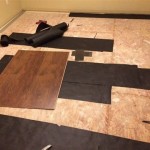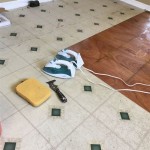How to Lay Sheet Vinyl Flooring on Concrete Without Damaging It
Sheet vinyl flooring is a popular choice for commercial and residential applications alike. Affordable, highly durable, and easy to clean, sheet vinyl flooring is also relatively easy to install. However, if it is improperly installed, it can damage the concrete subfloor. To avoid this, be sure to follow these essential steps.
1. Determine the Concrete’s Condition
Inspect the concrete subfloor carefully for any cracks, holes, or unevenness. If any of these imperfections are present, they will need to be repaired before you install the sheet vinyl flooring. Depending on the severity of the damage, you may need to patch the holes or cracks with concrete patching compound or level the floor with a self-leveling compound.
2. Clean the Concrete
Once the concrete subfloor is in good condition, it is important to clean it thoroughly. This will remove any dirt, dust, or debris that could interfere with the installation of the sheet vinyl flooring. Use a broom or vacuum cleaner to remove any loose debris, then mop the floor with a cleaner specifically designed for concrete.
3. Use a Level Subfloor
The concrete subfloor must be level in order to ensure a proper installation of the sheet vinyl flooring. If the floor is not level, it can cause the sheet vinyl to buckle or wrinkle. Use a level to check the floor for any unevenness and, if necessary, use a self-leveling compound to level the floor.
4. Roll out the Sheet Vinyl Flooring
Once the concrete subfloor is clean and level, you can roll out the sheet vinyl flooring. Cut the sheet vinyl to the size of the room, leaving about 2 inches of excess around the edges. Use a utility knife to make clean cuts.
5. Position the Sheet Vinyl Flooring
Once the sheet vinyl flooring is cut, position it in the room. Start by aligning the edges of the sheet with the walls of the room, making sure that the excess sheet is evenly distributed around the perimeter. Use a trowel to smooth out any wrinkles or bubbles.
6. Secure the Sheet Vinyl Flooring
Once the sheet vinyl flooring is positioned, you can secure it in place. Use a flooring adhesive specifically designed for sheet vinyl flooring. Apply the adhesive to the subfloor according to the manufacturer’s instructions. Then, carefully lower the sheet vinyl flooring into place and press it down firmly to ensure a good bond.
7. Seal the Edges
Once the sheet vinyl flooring is in place, you will need to seal the edges to prevent moisture from seeping in. Use a sealant specifically designed for sheet vinyl flooring and apply it to the edges of the floor according to the manufacturer’s instructions. This will help to keep the floor looking its best for years to come.
Additional Tips
- Allow the floor to acclimate to the room temperature for 24 hours before installing it.
- Use a sharp utility knife to make clean cuts.
- Be careful not to over-tighten the flooring, as this can cause it to buckle.
- If you are installing the flooring in a large room, use a seam sealer to join the seams of the flooring.
- Follow the manufacturer’s instructions carefully for the best results.

How To Prepare A Concrete Floor For Vinyl Flooring Parrys

Tips For Installing Vinyl Plank Over Concrete Floors Lemon Thistle

Tips For Installing Vinyl Plank Over Concrete Floors Lemon Thistle

How To Lay Sheet Vinyl Flooring
:max_bytes(150000):strip_icc()/SPR-installing-vinyl-floor-over-existing-floor-1822801-hero_53559-0b701293b4ee460896b5b11c7249b79e.jpg?strip=all)
Can You Put Vinyl Flooring Over Tile Or Other Floors

How To Install Sheet Vinyl Flooring

Vinyl Plank Flooring On Uneven Concrete

How To Lay Sheet Vinyl Flooring Installation 2024 Full Guide

How To Install Sheet Vinyl Floor Decor Adventures

Lvp Flooring Installation How To Install Luxury Vinyl Plank In A Basement Diy
See Also







